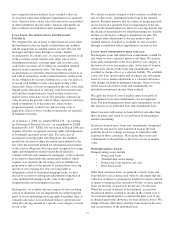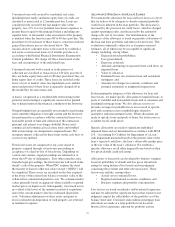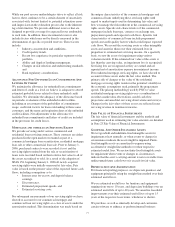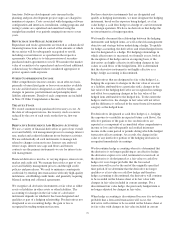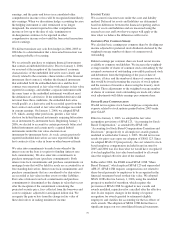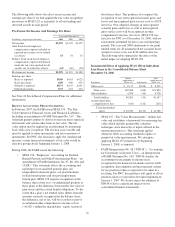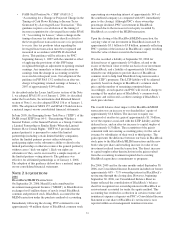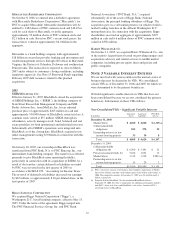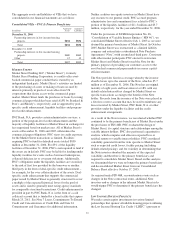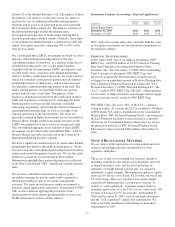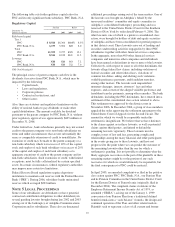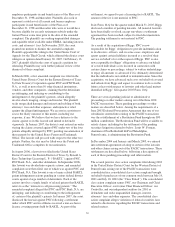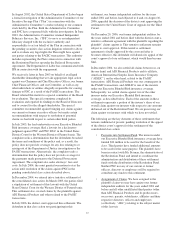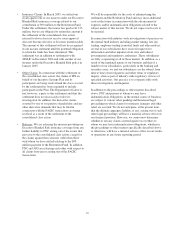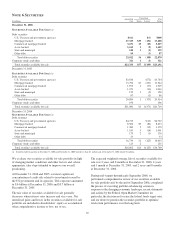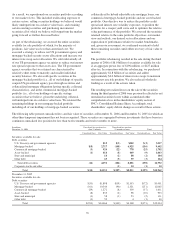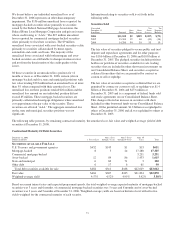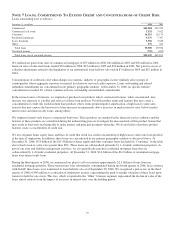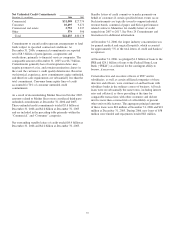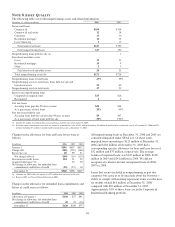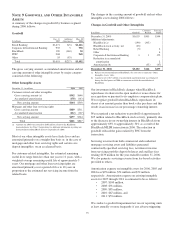PNC Bank 2006 Annual Report Download - page 95
Download and view the complete annual report
Please find page 95 of the 2006 PNC Bank annual report below. You can navigate through the pages in the report by either clicking on the pages listed below, or by using the keyword search tool below to find specific information within the annual report.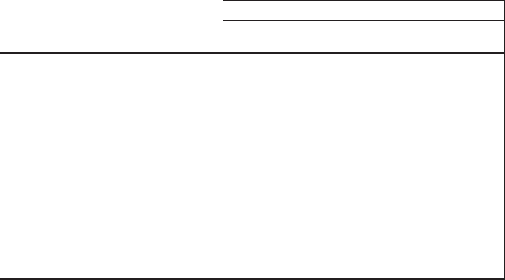
The following table sets forth regulatory capital ratios for
PNC and its only significant bank subsidiary, PNC Bank, N.A.
Regulatory Capital
Amount Ratios
December 31
Dollars in millions 2006 2005 2006 2005
Risk-based capital
Tier 1
PNC $ 8,924 $6,364 10.4% 8.3%
PNC Bank, N.A. 6,159 5,694 8.0 8.0
Total
PNC 11,559 9,277 13.5 12.1
PNC Bank, N.A. 8,541 8,189 11.1 11.5
Leverage
PNC NM NM 9.3 7.2
PNC Bank, N.A. NM NM 7.2 7.0
NM - Not Meaningful
The principal source of parent company cash flow is the
dividends it receives from PNC Bank, N.A., which may be
impacted by the following:
• Capital needs,
• Laws and regulations,
• Corporate policies,
• Contractual restrictions, and
• Other factors.
Also, there are statutory and regulatory limitations on the
ability of national banks to pay dividends or make other
capital distributions. The amount available for dividend
payments to the parent company by PNC Bank, N.A. without
prior regulatory approval was approximately $625 million at
December 31, 2006.
Under federal law, bank subsidiaries generally may not extend
credit to the parent company or its non-bank subsidiaries on
terms and under circumstances that are not substantially the
same as comparable extensions of credit to nonaffiliates. No
extension of credit may be made to the parent company or a
non-bank subsidiary which is in excess of 10% of the capital
stock and surplus of such bank subsidiary or in excess of 20%
of the capital and surplus of such bank subsidiary as to
aggregate extensions of credit to the parent company and its
non-bank subsidiaries. Such extensions of credit, with limited
exceptions, must be fully collateralized by certain specified
assets. In certain circumstances, federal regulatory authorities
may impose more restrictive limitations.
Federal Reserve Board regulations require depository
institutions to maintain cash reserves with the Federal Reserve
Bank (“FRB”). During 2006, subsidiary banks maintained
reserves which averaged $203 million.
N
OTE
5L
EGAL
P
ROCEEDINGS
Some of our subsidiaries are defendants (or have potential
contractual contribution obligations to other defendants) in
several pending lawsuits brought during late 2002 and 2003
arising out of the bankruptcy of Adelphia Communications
Corporation and its subsidiaries. There also are threatened
additional proceedings arising out of the same matters. One of
the lawsuits was brought on Adelphia’s behalf by the
unsecured creditors’ committee and equity committee in
Adelphia’s consolidated bankruptcy proceeding and was
removed to the United States District Court for the Southern
District of New York by order dated February 9, 2006. The
other lawsuits, one of which is a putative consolidated class
action, were brought by holders of debt and equity securities
of Adelphia and have been consolidated for pretrial purposes
in that district court. These lawsuits arise out of lending and
securities underwriting activities engaged in by these PNC
subsidiaries together with other financial services companies.
In the aggregate, more than 400 other financial services
companies and numerous other companies and individuals
have been named as defendants in one or more of the lawsuits.
Collectively, with respect to some or all of the defendants, the
lawsuits allege federal law claims, including violations of
federal securities and other federal laws, violations of
common law duties, aiding and abetting such violations,
voidable preference payments, and fraudulent transfers,
among other matters. The lawsuits seek unquantified
monetary damages, interest, attorneys’ fees and other
expenses, and a return of the alleged voidable preference and
fraudulent transfer payments, among other remedies. The bank
defendants, including the PNC defendants, have entered into a
settlement of the consolidated class action referred to above.
This settlement was approved by the district court in
November 2006. In December 2006, a group of class members
appealed the order approving the settlement agreement to the
United States Court of Appeals for the Second Circuit. The
amount for which we would be responsible under this
settlement is insignificant. We believe that we have defenses
to the claims against us in these lawsuits, as well as potential
claims against third parties, and intend to defend the
remaining lawsuits vigorously. These lawsuits involve
complex issues of law and fact, presenting complicated
relationships among the many financial and other participants
in the events giving rise to these lawsuits, and have not
progressed to the point where we can predict the outcome of
the remaining lawsuits other than the one for which a
settlement is pending. It is not possible to determine what the
likely aggregate recoveries on the part of the plaintiffs in these
remaining matters might be or the portion of any such
recoveries for which we would ultimately be responsible, but
the final consequences to PNC could be material.
In April 2005, an amended complaint was filed in the putative
class action against PNC, PNC Bank, N.A., our Pension Plan
and its Pension Committee in the United States District Court
for the Eastern District of Pennsylvania (originally filed in
December 2004). The complaint claims violations of the
Employee Retirement Income Security Act of 1974, as
amended (“ERISA”), arising out of the January 1, 1999
conversion of our Pension Plan from a traditional defined
benefit formula into a “cash balance” formula, the design and
continued operation of the Plan, and other related matters.
Plaintiffs seek to represent a class of all current and former
85


